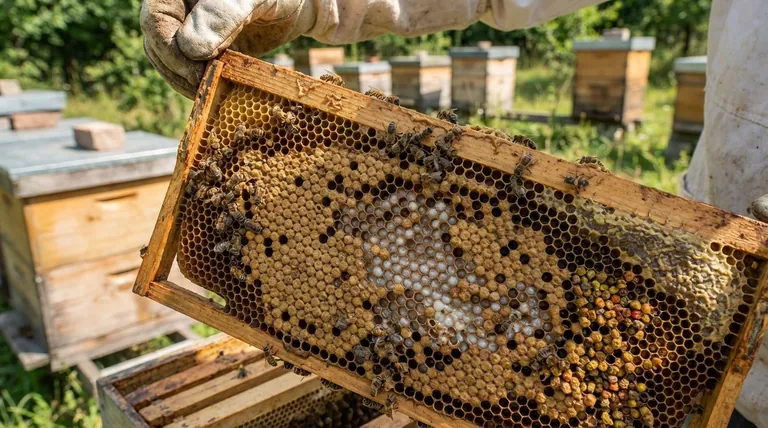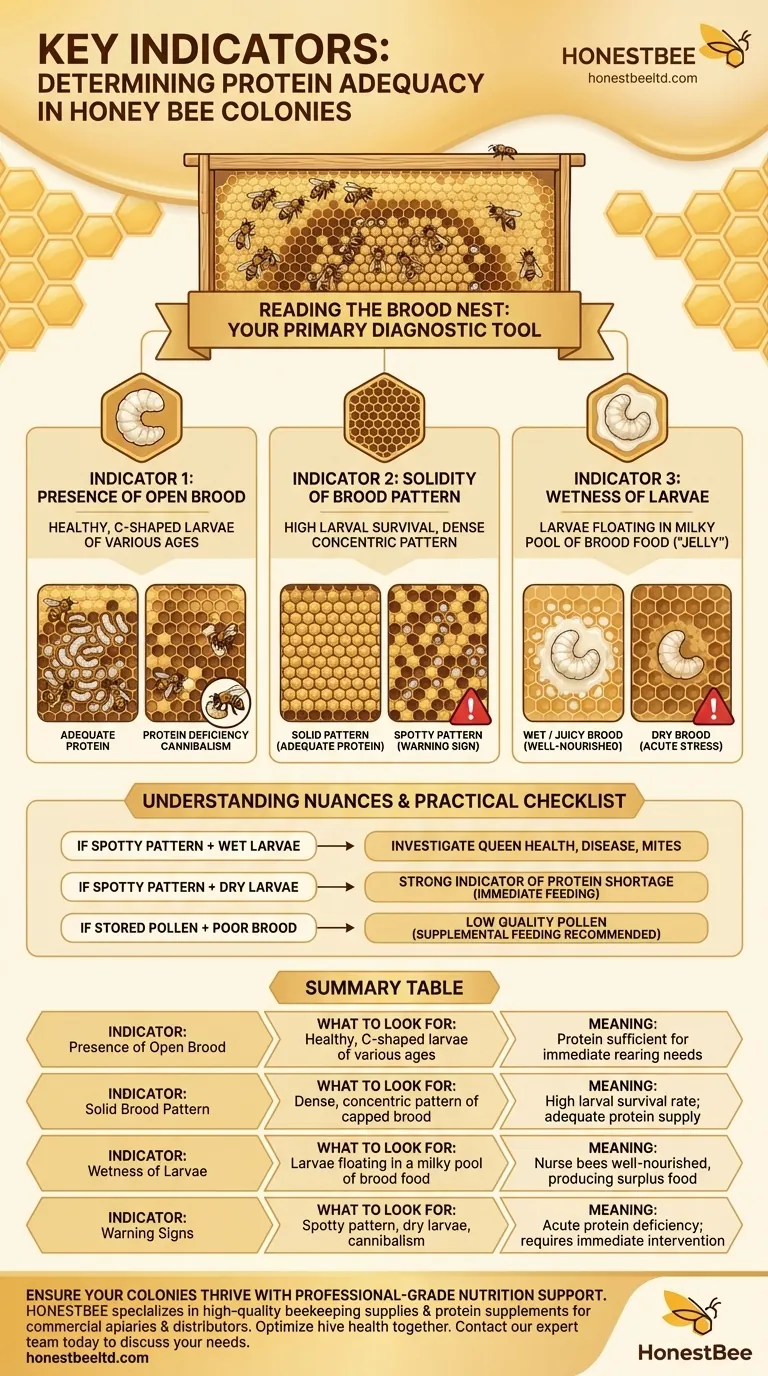To assess protein adequacy in a honey bee colony, you must look beyond stored pollen and directly inspect the brood nest. The key indicators are the presence of young larvae, the uniformity of the brood pattern, and the amount of brood food surrounding the larvae. A colony suffering from protein deficiency will begin to cannibalize its young, revealing a spotty or disappearing brood pattern long before the hive shows other signs of stress.
A beekeeper's most reliable tool for diagnosing protein deficiency isn't a lab test, but a careful visual inspection of the brood frames. The presence, pattern, and "wetness" of the developing larvae provide a direct and immediate report card on the colony's nutritional status.

Reading the Brood: Your Primary Diagnostic Tool
The brood nest is the engine of the colony. Its health and growth are directly fueled by protein, which nurse bees consume to produce the royal jelly and brood food needed to raise the next generation. By learning to read the brood frame, you can accurately gauge the hive's nutritional health.
Indicator 1: The Presence of Open Brood
The first and most basic sign of sufficient protein is that the bees are actively rearing larvae.
Nurse bees require a constant supply of high-quality protein to stimulate their hypopharyngeal glands, which produce brood food. When protein becomes scarce, these glands shrink, and bees will resort to cannibalism, consuming eggs and the youngest larvae to recycle precious nutrients.
Therefore, seeing frames with healthy, C-shaped larvae of various ages is the first positive confirmation that protein intake is meeting the colony's immediate needs.
Indicator 2: The Solidity of the Brood Pattern
A well-nourished colony exhibits a high larval survival rate, which is visible as a solid brood pattern.
A healthy queen lays eggs in a dense, concentric pattern. In a well-fed hive, these eggs hatch and the larvae survive to be capped as pupae, creating a solid wall of even-aged brood. This indicates that nurse bees had enough protein to feed every larva through development.
Conversely, a "shotgun" or spotty brood pattern, where cells of capped brood are interspersed with empty cells or young larvae, is a critical warning sign. It often means larvae starved before they could be capped, a classic symptom of a protein shortage.
Indicator 3: The "Wetness" of the Larvae
The most sensitive indicator of current protein availability is the amount of brood food, or "jelly," you see.
Well-fed larvae should be visibly floating in a generous, milky pool of brood food. These are often called "wet" or "juicy" brood. This shows that nurse bees are well-nourished and producing a surplus of food.
When protein is restricted, nurse bees provide only the minimum amount of food required. The larvae may appear "dry" and not be sitting in a visible pool of jelly. This is a sign of acute nutritional stress and indicates the colony is on the verge of starvation, even if they haven't yet started cannibalizing larvae on a large scale.
Understanding Nuances and Common Misinterpretations
Observing the brood frame tells a story, but it's important to interpret it correctly. A poor brood pattern is not always caused by a lack of protein.
Brood Pattern vs. Queen Health
A spotty brood pattern can also be a symptom of a failing or poorly-mated queen who is laying unfertilized eggs or has an inconsistent laying rate. It can also be caused by brood diseases like Chalkbrood or European Foulbrood (EFB).
Differentiate by looking at the larvae themselves. If the pattern is spotty but the visible larvae are "wet" and well-fed, the problem is more likely the queen or a disease. If the pattern is spotty and the larvae look "dry," the primary issue is nutritional.
The Limitations of Observing Pollen Stores
Seeing frames packed with stored pollen, or bee bread, can create a false sense of security. The mere presence of pollen does not guarantee the colony is well-nourished.
Pollen varies dramatically in its protein content and amino acid profile. A colony can bring in large quantities of low-quality "junk food" pollen that fails to support proper larval development. The true test of pollen quality is not how much is stored, but how well the brood is being reared.
A Practical Checklist for Your Hive Inspection
Use these indicators during your hive inspections to make informed management decisions.
- If you see a solid, wet brood pattern: Your colony has adequate protein for its current needs, and no immediate intervention is required.
- If you see a spotty pattern with dry-looking larvae: This is a strong indicator of a protein shortage. Consider immediate supplemental feeding with a quality pollen substitute.
- If you see a spotty pattern but the larvae appear wet and well-fed: Investigate other causes, such as queen health, varroa mite levels, or brood diseases, before assuming a nutritional problem.
- If you see frames of stored pollen but the brood quality is poor: The available pollen may be of low quality. Supplemental feeding is a wise precaution to ensure the colony has balanced nutrition for growth.
By learning to read the story told in the brood nest, you can proactively manage colony nutrition and ensure your bees have the resources they need to thrive.
Summary Table:
| Indicator | What to Look For | Meaning |
|---|---|---|
| Presence of Open Brood | Healthy, C-shaped larvae of various ages | Protein is sufficient for immediate rearing needs |
| Solid Brood Pattern | Dense, concentric pattern of capped brood | High larval survival rate; adequate protein supply |
| Wetness of Larvae | Larvae floating in a milky pool of brood food | Nurse bees are well-nourished and producing surplus food |
| Warning Signs | Spotty pattern, dry larvae, cannibalism | Acute protein deficiency; requires immediate intervention |
Ensure your colonies thrive with professional-grade nutrition support.
As HONESTBEE, we specialize in supplying high-quality beekeeping supplies and equipment to commercial apiaries and distributors through wholesale-focused operations. Whether you're managing a large-scale operation or distributing to beekeepers, our protein supplements and feeding solutions are formulated to prevent nutritional stress and promote robust brood development.
Let's optimize your hive health together.
Contact our expert team today to discuss your specific needs and discover how our products can enhance your colony's productivity and resilience.
Visual Guide

Related Products
- No Grafting Queen Rearing Kit: System for Royal Jelly Production and Queen Rearing
- Vertical Motor Kits for 2 3 4 Frame Electric Honey Extractors
- Heavy-Duty Plier Action Frame Grip
- HONESTBEE 6 Frame Three Use Electric Honey Extractor for Beekeeping
- Circular Labyrinth Bee Escape for Efficient Hive Management
People Also Ask
- What are the two main categories of queen rearing methods? Grafting vs. Non-Grafting Explained
- What is requeening, and why is it performed? Take Control of Your Hive's Health and Productivity
- What are the signs that indicate a colony needs requeening? Protect Your Hive's Health and Productivity
- What is the timeline for queen breeding? A 28-Day Guide from Egg to Laying Queen
- What are the stages involved in queen raising? A Guide to Controlled, High-Quality Queen Production



















